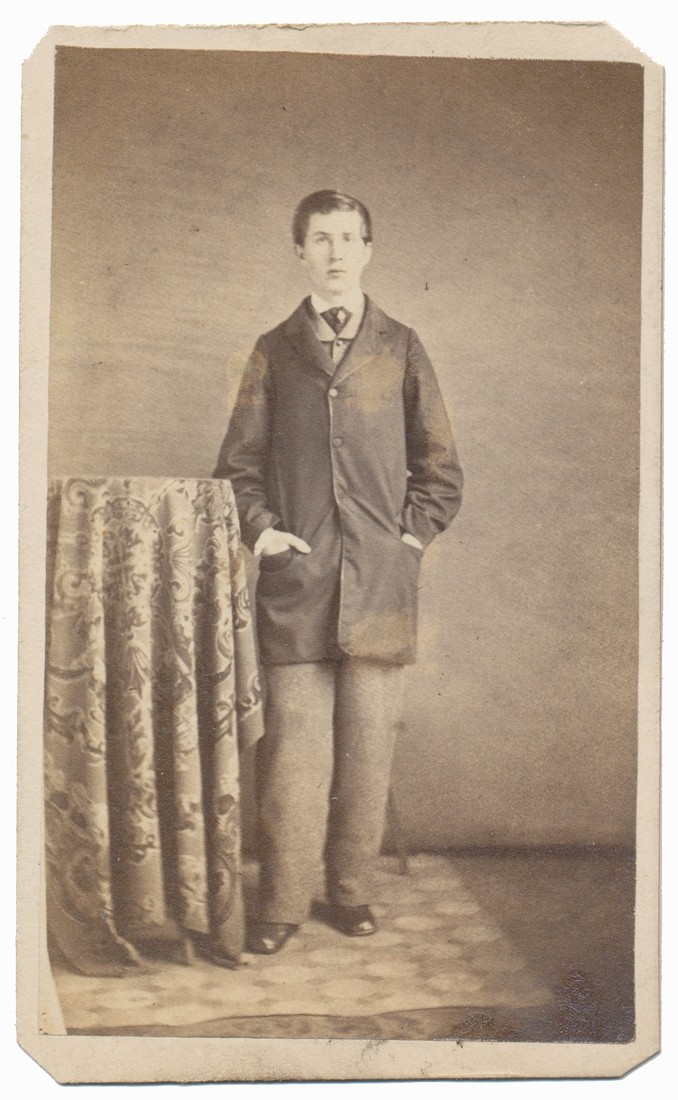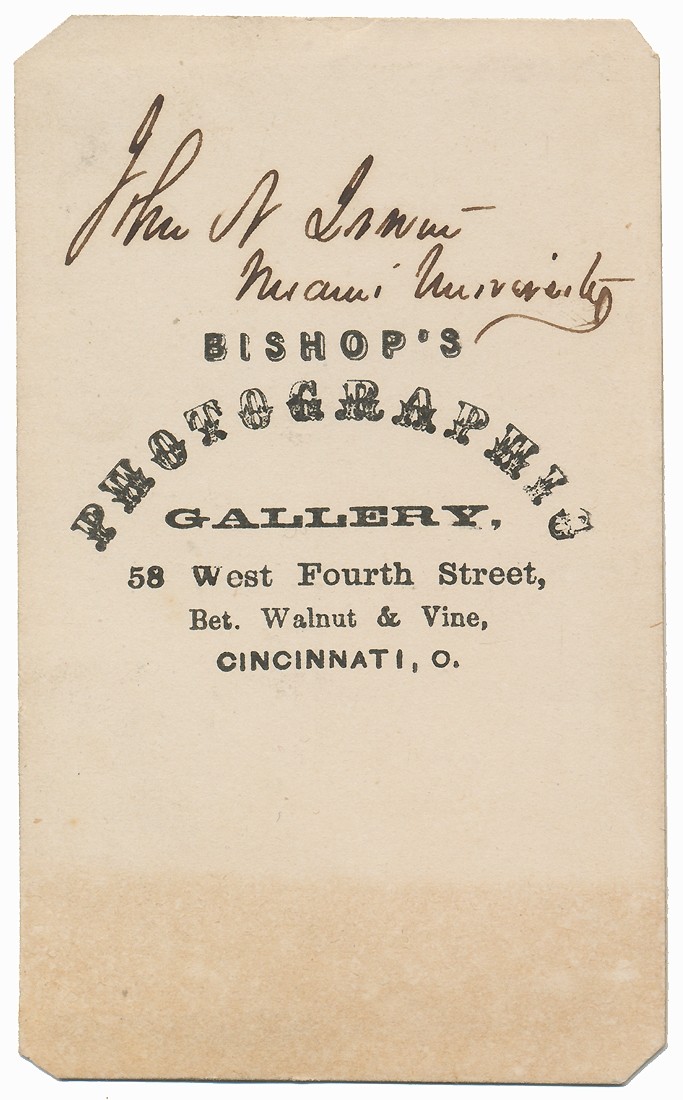site search
online catalog
FULL STANDING INK ID CDV OF 45TH IOWA SOLDIER AND POST-WAR GOVERNOR OF IDAHO AND ARIZONA TERRITORY JOHN N. IRWIN

Hover to zoom


$125.00
Quantity Available: 1
Item Code: 766-1128
Image shows a young Union private posed by a table with his hands resting in the lower pockets of a dark commercial sack coat with light trousers. It is hard to tell if the coat is a military or civilian item.
Image has excellent clarity and contrast. Paper and mount are good but mount corners have been slightly clipped. Mount edges have light surface dirt.
Reverse has a large photographer’s imprint for BISHOP’S PHOTOGRAPHIC GALLERY…CINCINNATI, O. Above the imprint is a bold period ink signature that reads “JOHN N. IRWIN, MIAMI UNIVERSITY.”
John Nichol Irwin was 18 years old and a student in Keokuk, Iowa when he enlisted for 100 days as a 3rd sergeant in Company C, 45th Iowa Infantry on May 25, 1864. The regiment was held in Tennessee where it guarded the railroad lines. Irwin was mustered out on September 16, 1864.
An online biography of Irwin reads:
“John N. Irwin was born December 25, 1844, in Butler County, Ohio, to Stephen and Elizabeth Martha (Nichol) Irwin. His family moved to Keokuk, Iowa, in 1856 and he was educated in public schools in both Ohio and Iowa before attending Miami University in his birth state. His education was interrupted by the Civil War, when Irwin served with the 45th Iowa Volunteer Infantry Regiment, and reached the rank of sergeant. Following the war he returned to his studies and graduated from Dartmouth College in 1867. He was a member of Delta Kappa Epsilon fraternity.
After graduation, Irwin returned to Keokuk and studied law at the firm of Miller and Rankin. He additionally studied for a time at the University of Michigan Law School. On June 6, 1871, he married his mentor's daughter, Mary Love Rankin. The couple had three children, Alice, Elizabeth, and John R.
Despite his legal training, Irwin spent most of his efforts working at the family dry goods business. Performing occasional legal work, he also became a founder and director of the Keokuk Building and Loan Company. He served five terms as mayor of Keokuk and two terms in the Iowa House of Representatives.
Following the removal of John Baldwin Neil, Irwin was nominated as Governor of Idaho Territory by President Chester A. Arthur and commissioned on March 5, 1883. Arriving in the territory in April, he took a brief tour with Theodore F. Singiser before returning to Keokuk to handle personal business and prepare his family to move to the territory. At the end of a 60-day leave, he requested and received a 60-day extension. In August, news reached Idaho that Irwin had developed problems with his eyes. By October, the new governor was expressing his desire to soon return to his duties while at the same time expecting to undergo surgery to correct the problem with his eyes. Citing "personal reasons", Irwin submitted his resignation on December 20, 1883. During his tenure of over nine months as governor, he had spent less than one month in the territory.
An unusual aspect of his tenure was Irwin returning most of his salary, claiming he could not in good conscience accept the unearned pay. This action received widespread newspaper results due to its rarity – most political appointees of the day took all monies they could collect without question. It also created a problem for the Treasury Department which was unsure how to handle the situation. They initially attempted to place the returned money in the Conscience Fund, but this resulted in a protest from Irwin who did not wish the returned salary to be associated with monies returned by guilt-ridden criminals. The returned funds were eventually credited to the public debt.
Following the resignation of Lewis Wolfley as Governor of the Arizona Territory, President Benjamin Harrison took over a month to choose a replacement. Upon the recommendation of U.S. Senator William B. Allison, Irwin was nominated for the governorship on September 29, 1890, and confirmed on October 4, 1890.The new governor was however delayed in assuming his new position, being quarantined in his home after his son was diagnosed with scarlet fever till January of the next year.
Irwin was sworn into office on January 21, 1891.By this time the 16th Arizona Territorial Legislature was already in session. Secretary Oakes Murphy, as Acting Governor, had already given the session's opening address, so Irwin made his wishes felt through use of his veto. To help control the territorial deficit the governor vetoed an "outrageous" appropriation bill, forcing the legislature to pass a less ambitious spending plan. Irwin was however convinced to sign a twenty-year tax exemption on newly constructed railroad lines.
Among the other actions of the 16th legislature was an act calling for a constitutional convention. In response to this act, Irwin called a special election to choose delegates. A constitution was written by the convention and approved by Arizona voters in 1891, but the document never received serious consideration by interests in the U.S. Congress due to its provisions supporting Free Silver, state control of rivers and canals, and state aid to railroads and other businesses.
On June 15, 1891, Irwin left for the East Coast. At the time of his departure the territory's bonds were selling for below par and the governor wished to negotiate with New York financial interests about the territorial debt. He also used the visit to extol Arizona's virtues during a July 28, 1891, dinner. Following his stay in New York he returned to Keokuk to continue his work of refinancing the territorial debt.
While in Keokuk, Irwin found his mother had taken ill. This prompted him to extend his stay and he did not return to Arizona until November 9, 1891. Irwin's mother became ill again in April 1892, prompting the governor to return to Iowa. Following his mother's death, Irwin submitted his resignation on April 18, 1892, to deal with resulting family business concerns
After leaving Arizona, Irwin made his home in Keokuk. He remained there till 1899 when he was appointed Minister to Portugal.[18] Irwin resigned his diplomatic appointment in June 1901.
Irwin's death occurred on December 22, 1905, in Hot Springs, Arkansas. He was buried in Keokuk's Oakland Cemetery.” [AD]
~~~~~~~~~~~~~~~~~~~~~~~~~~~~~~~~~~~
THIS ITEM, AS WITH ALL OTHER ITEMS AVAILABLE ON OUR WEB SITE,
MAY BE PURCHASED THROUGH OUR LAYAWAY PROGRAM.
FOR OUR POLICIES AND TERMS,
CLICK ON ‘CONTACT US’ AT THE TOP OF ANY PAGE ON THE SITE,
THEN ON ‘LAYAWAY POLICY’.
THANK YOU!
Inquire About FULL STANDING INK ID CDV OF 45TH IOWA SOLDIER AND POST-WAR GOVERNOR OF IDAHO AND ARIZONA TERRITORY JOHN N. IRWIN
Most Popular
Historical Firearms Stolen From The National Civil War Museum In Harrisburg, Pa »
Theft From Gravesite Of Gen. John Reynolds »
Selection Of Unframed Prints By Don Troiani »
Fine Condition Brass Infantry Bugle Insignia »
Large English Bowie Knife With Sheath 1870’S – 1880’S »
Imported (Clauberg) Us Model 1860 Light Cavalry Officer's Saber »
featured item
FANTASTIC FRAMED DRAWING OF THE BATTLE OF DRAINSVILLE DONE BY GETTYSBURG CARTOGRAPHER EMMOR B. COPE
This wonderful and detailed drawing shows the meeting engagement on December 20, 1861 between a brigade of Pennsylvania Reserve regiments under Brig. Gen. E. O. C. Ord and a mixed Confederate force led by Gen. J. E. B. Stuart. The scene was drawn by… (1054-2733). Learn More »


